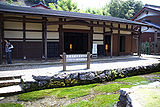
Tonya (Japan)
Encyclopedia

Edo
, also romanized as Yedo or Yeddo, is the former name of the Japanese capital Tokyo, and was the seat of power for the Tokugawa shogunate which ruled Japan from 1603 to 1868...
, were trade brokers in Japan
Japan
Japan is an island nation in East Asia. Located in the Pacific Ocean, it lies to the east of the Sea of Japan, China, North Korea, South Korea and Russia, stretching from the Sea of Okhotsk in the north to the East China Sea and Taiwan in the south...
, primarily wholesalers, warehouse managers, and shipment managers; the term applies equally to the traders themselves and to their shops or warehouses. First appearing as early as the 12th century, ton'ya came to serve a crucial role in the economy of the Edo period
Edo period
The , or , is a division of Japanese history which was ruled by the shoguns of the Tokugawa family, running from 1603 to 1868. The political entity of this period was the Tokugawa shogunate....
(1603-1867).
History
The earliest record of a toi-otoko (問男) may be one from 1175, in which a number of Court officials hire an outside boatsman to transport them down the Yodo River. As he was not a servant or agent of the Court, or any manor, but rather a man hired out privately, this represents the emergence of the sorts of private enterprises which would come to dominate the economy centuries later.The ton'ya of the Edo period were little different, essentially acting as independent agents for specific elements of the domestic trade; most often they were shippers, but many were local handlers, middlemen, or warehousers. They would be hired by a firm (a merchant, a shop, etc.) which operated out of one of the big cities to manage or handle the firm's goods in some other portion of the country. Wholesale freight shippers operating out of Osaka
Osaka
is a city in the Kansai region of Japan's main island of Honshu, a designated city under the Local Autonomy Law, the capital city of Osaka Prefecture and also the biggest part of Keihanshin area, which is represented by three major cities of Japan, Kyoto, Osaka and Kobe...
, transporting goods to Edo, numbered at least 24 in 1700, and a great many "guilds" existed specializing in the handling of individual types of goods, such as cotton, sugar, or paper. In addition, there were groups such as the Satsuma Tonya and the Matsumae clan
Matsumae clan
The was a Japanese clan which was granted the area around Matsumae, Hokkaidō as a march fief in 1590 by Toyotomi Hideyoshi, and charged with defending it, and by extension all of Japan, from the Ainu 'barbarians' to the north. The clan was originally known as the Kakizaki clan who settled...
Tonya, who specialized in the handling and transportation of goods within two of Japan's four great "gates" to the outside world; Matsumae, in Hokkaidō
Hokkaido
, formerly known as Ezo, Yezo, Yeso, or Yesso, is Japan's second largest island; it is also the largest and northernmost of Japan's 47 prefectural-level subdivisions. The Tsugaru Strait separates Hokkaido from Honshu, although the two islands are connected by the underwater railway Seikan Tunnel...
, governed the trade with the Ainu
Ainu people
The , also called Aynu, Aino , and in historical texts Ezo , are indigenous people or groups in Japan and Russia. Historically they spoke the Ainu language and related varieties and lived in Hokkaidō, the Kuril Islands, and much of Sakhalin...
and Imperial Russia, while Satsuma, in Kyūshū
Kyushu
is the third largest island of Japan and most southwesterly of its four main islands. Its alternate ancient names include , , and . The historical regional name is referred to Kyushu and its surrounding islands....
, controlled trade with the Ryūkyū Kingdom
Ryukyu Kingdom
The Ryūkyū Kingdom was an independent kingdom which ruled most of the Ryukyu Islands from the 15th century to the 19th century. The Kings of Ryūkyū unified Okinawa Island and extended the kingdom to the Amami Islands in modern-day Kagoshima Prefecture, and the Sakishima Islands near Taiwan...
and, through them, trade with Qing China.
Between the ton'ya and the numerous other types of groups in Osaka and Edo, including kabunakama
Kabunakama
Kabunakama were merchant guilds in Edo period Japan, which evolved out of the more basic merchants' associations known as nakama. The kabunakama were entrusted by the shogunate to manage their respective trades, and were allowed to enjoy a monopoly in their given field.Some kabunakama, known as...
, rakuza, and rice brokers, Japan's primary urban commercial centers were extremely organized and powerful by the middle of the Edo period. Most of these groups would dissolve or evolve into something else entirely by the end of the Edo period, but they served an important role in facilitating the emergence of fully nation-wide trade in early modern Japan.
See also
- HonjinHonjinthumb|250px|The honjin at [[Inaba Kaidō]]'s [[Ōhara-shuku]]. is the Japanese word for an inn for government officials, generally located in post stations during the later part of the Edo period.-Evolution of Honjin:...
- HatagoHatagowere Edo period lodgings for travelers at shukuba along the national highways, including the Edo Five Routes and the subroutes. In addition to a place to rest, hatago also offered meals and other foods to the travelers...
- Kichinyado
- ChayaChayaCnidoscolus aconitifolius, commonly known as Chaya or Tree Spinach, is a large, fast growing leafy perennial shrub that is believed to have originated in the Yucatán Peninsula of Mexico. The specific epithet, "aconitifolius", refers to its Aconitum-like leaves. It has succulent stems which exude a...
- Kōsatsu

